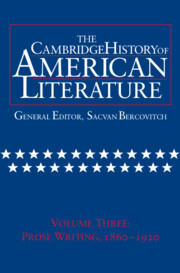Book contents
- Frontmatter
- Introduction
- THE AMERICAN LITERARY FIELD, 1860–1890
- LITERARY FORMS AND MASS CULTURE, 1870–1920
- PROMISES OF AMERICAN LIFE, 1880–1920
- 1 An American tragedy, or the promise of American life
- 2 The production of visibility
- 3 The contracted heart
- 4 Success
- BECOMING MULTICULTURAL: CULTURE, ECONOMY, AND THE NOVEL, 1860–1920
- Chronology 1860–1920
- Bibliography
- Index
1 - An American tragedy, or the promise of American life
from PROMISES OF AMERICAN LIFE, 1880–1920
Published online by Cambridge University Press: 28 March 2008
- Frontmatter
- Introduction
- THE AMERICAN LITERARY FIELD, 1860–1890
- LITERARY FORMS AND MASS CULTURE, 1870–1920
- PROMISES OF AMERICAN LIFE, 1880–1920
- 1 An American tragedy, or the promise of American life
- 2 The production of visibility
- 3 The contracted heart
- 4 Success
- BECOMING MULTICULTURAL: CULTURE, ECONOMY, AND THE NOVEL, 1860–1920
- Chronology 1860–1920
- Bibliography
- Index
Summary
CLASSES AND INDIVIDUALS
Young women in Dreiser's An American Tragedy (1925) talk baby talk to the objects of their desire; that is what alerts us to the connection between Sondra Finchley's desire for Clyde Griffiths – “Sondra so glad Clydie here,” she tells him, and Hortense Briggs's desire for the coat in the window of Rubenstein's fur store – “Oh, if I could only have 'oo,” Hortense says to the coat. Whether the girls understand themselves or the objects as infantilized by their desires is unclear; Clyde calls Sondra his “darling baby girl” but what Sondra likes about Clyde is how “dependent” he is “upon her” – which one is the baby? Things are a little more straightforward between Hortense and the coat but only, perhaps, because what the coat has to offer Hortense is so much more obvious than what Clyde has to offer Sondra. The coat is the “darlingest” because it is the “classiest”; where Clyde represents for Sondra a social problem, as we will see, analogous in its double-edgedness to the psychological one of dependency, the coat represents to Hortense an unambiguously upward transformation of her “social state.” The coat has “class” and wearing it, Hortense imagines, she will begin to belong to the class it has.
As the analogy between the coat and Clyde suggests, class transformation and erotic attraction are deeply linked in An American Tragedy, which, in concerning itself with love affairs that cross class boundaries, sees those boundaries not as obstacles to love but as the conditions of its possibility.
- Type
- Chapter
- Information
- The Cambridge History of American Literature , pp. 285 - 314Publisher: Cambridge University PressPrint publication year: 2005



